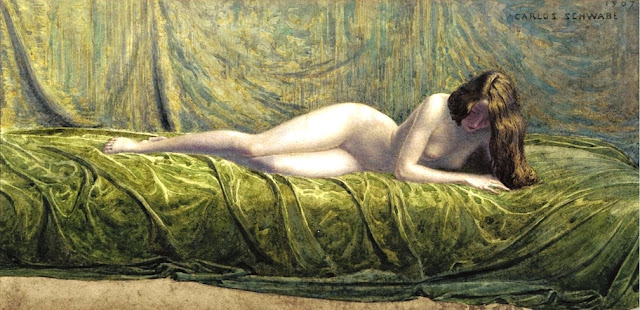DELIVER ME FROM EVA is a dark-thriller that was first
published in 1946 by Murray & Gee Incorporated of Hollywood,
California. It has since gone on to gain some cult status within the horror
genre. To begin with, it found a permanent place in Stephen Jones' &
Kim Newman's influential, annotated reading list, Horror: 100 Best Books
(Carroll & Graf, 1988), with a conveying essay by genre aficionado
Forrest J. Ackerman. Then in 2007 it was republished as a high quality,
limited edition hardback by Centipede Press, a unique specialty publisher out
of Lakewood, Colorado.
In Centipede's newly commissioned introduction,
Ackerman, once again, states his admiration for the novel and his still
ardent desire to see a film made of it. Regrettably, a film was never
opted, nor has the novel been published in convenient mass-market
paperback format. Though in 2011, at long last, Paul Bailey's novel was
republished in an affordable trade softcover edition by Bruin Books, a
highly commendable Golden Age Fiction revival house.
The original Murray & Gee jacket art, with its severed head served on a silver platter, was produced by Jack Lynch,
on whom I could find no information about beyond the fact that he
provided additional cover art for the publisher during their post WWII height (see further examples below).
"When he'd (the publisher) finished the last gripping line his blood was running as cold as a lizard's belly, and for a week he dared not turn off his lights at night... we swear it's the most gosh-awful, horrific spine-tingler imaginable, but we're not revealing any of its awesome secrets."
That type of prelude may seem a tad old fashioned today, but it certainly evokes, or at least promotes, an anticipation of mystery, suspense, and the preternatural to follow. And follow it does! Bailey's unique plot centers around complications ensuing from experiments to increase intelligence artificially. This scientific aspect allows for some unpredictable turns and grotesqueries to develop, and Bailey delivers them all in Grand Guignol style. I was enthralled by every aspect of his story; the whirlwind romance, the majestic manor-house setting, the increasingly bizarre revelations, the madcap science, the black humor---but also by the beguiling, femme fatale Eva Craner, possessor of amazing intellectual abilities and astounding musical capabilities, who is strangely obligated to the weird demands of her arcane family. One of those family members suffers a fateful introspection that quickly becomes the catalyst for the story's shocking finish.
And yes, Ackerman was right---it's ideal B-movie material.
Bailey has crafted a tremendously lurid, atmospheric horror novel that can also double as a weird mystery or even a unique science-fiction novel. It's a remarkable achievement for a writer with no previous experience in the realm of the fantastic.
 |
| CLICK ON IMAGE TO ENLARGE |
The 2011 Bruin Books softcover featured an anatomical drawing of the human body by Sixteenth-Century Dutch engraver and artist Jan Wandelaar (1690-1759), one of forty incredibly detailed drawings of the human body that he produced over an eight year period in collaboration with his friend, the Dutch physician and anatomist Bernhard Siegfried Albinus (1697-1770). These were originally published in 1747, in a volume titled Tabulae sceleti et musculorum corporis humani (Tables of the skeleton and muscles of the human body).
BELOW: BONUS ILLUSTRATIONS FROM Lynch, Schwabe and Wandelaar/Albinus:
Jack Lynch
Nobody Loves A Dead Man and The Gay Mortician by Milton M. Raison (1903-1982) were published in hardback by Murray & Gee in 1945 and 1946 respectively. The jacket art for both mystery novels were produced by Jack Lynch. In addition to the above titles, Raison wrote four more mysteries: The Phantom of Forty-Second Street (Macaulay, 1936), No Weeds for the Widow (Murray, 1947), Murder in a Lighter Vein (Murray, 1947), and Tunnel 13 (Murray, 1948), though his first published book was Spindrift (Doran, 1922), a book of verse, which he wrote while working at sea as a young lad. Raison was primarily a screenwriter in Hollywood for both film and television, largely for B programmers and television episodes, with over 70 total credits. He was also a special feature writer for the Sunday World, a reviewer for the Herald Tribune and the New York Record, a freelance magazine writer for popular slicks, a radio writer, and a publicity agent for many of Broadway's shows and producers.
Jack Lynch also produced the cover art and interior illustrations for the children's book The Quinducklets, The Adventures of Five Little Ducks, by Ruth & Helen Rames. It was published in hardback by Murray & Gee in 1945. Helen Rames Briggs (1908-2010) was a longtime resident of Glendale, California, and for many years she owned and operated a bookstore there, but she was also a determined writer, publishing more than 50 articles, poems and children's stories. She is the author of just this one book though, co-written with her sister Ruth Rames Munson (1907-1994).
* * * * *
Carlos Schwabe
Les Fleurs du Mal (Flowers of Evil), by Carlos Schwabe, from a 1900 book of lyric poetry by Charles Baudelaire. Medium: pencil, watercolor and gouache.
Les Champs-Elysees (Elysian Fields) by Carlos Schwabe, circa 1903. Medium: pencil, watercolor and gouache.
 |
| CLICK ON IMAGE TO ENLARGE |
De Jade (Jade Ring) by Carlos Schwabe, circa 1900. Medium: oil (?).
HAPPY HALLOWEEN!
[October, 2019, © Jeffersen]


















No comments:
Post a Comment